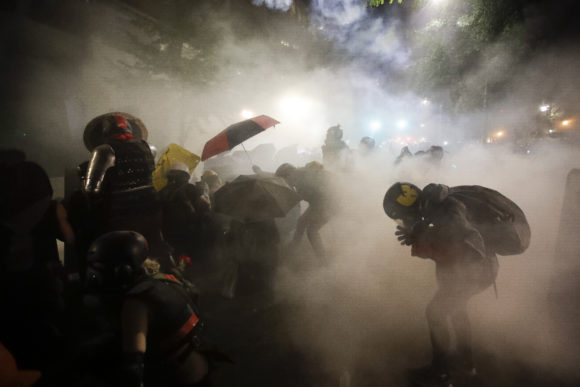These are turbulent times. In the last year, cities have experienced many episodes of civil unrest with significant property damage and loss, physical harm to people.
For our purposes, “civil unrest” encompasses three types of conduct. First, spontaneous or planned protests can morph into riots or civil commotion with vandalism, looting and wanton destruction. Next, terroristic groups or individuals can cause similar mayhem. Third, individuals, groups or movements motivated by a range of purposes can become violent, at times elevating the level of violence of other protestors by supplying weapons such as Molotov cocktails.
On March 17, the Office of the Director of National Intelligence released an unclassified assessment of domestic violent extremism. The first paragraph states that domestic violent extremists “who are motivated by a range of ideologies and galvanized by recent political and societal events in the United States post an elevated threat to the Homeland in 2021.”

The lines of this trichotomy can be blurred, with motives and causation difficult or impossible to ascertain or prove. But the distinctions have important consequences for insurance coverage purposes.
The starting point is the policy language, which sets the fundamental structure for coverage. Where questions of interpretation arise, they are resolved by judicial interpretations of state law, which varies across jurisdictions. Coverage determinations can require detailed, deeply drilled-down analysis.
Coverage for protest-based civil unrest
The most likely coverage for civil unrest is commercial property and casualty insurance. Coverage can arise from perils such as riots or civil commotion being identified as a Covered Cause of Loss, or from failure to exclude them. Conversely, some policies expressly exclude these perils. Where policies define these terms, the definitions are of course key. Often, though, policies do not to define these terms. But various statutes and courts have. Common definitions of “riot” require a public disturbance involving (1) an act of violence by one or more persons in a group of three or more persons, which act constitutes a clear and present danger of, or results in, damage or injury to the property of any other person or to the person of another individual or (2) a threat or threats of the commission of an act of violence by one or more in a group of three or more persons.
Civil commotion definitions are similar to riots, but the term is generally construed as requiring a more serious disturbance or a series of disturbances.
Other related coverages that may apply include vandalism (intentional damage or destruction of property) and malicious mischief (acts motivated by spite or hatred that result in damage or destruction that might not have been intended).
The scope of coverage typically extends to property damage, including destroyed, damaged, burned, or looted property, graffiti damage, and debris removal. There can also be coverage for lost income, subject to waiting periods (typically three days). The insurance may also cover costs incurred to protect against future, imminent harm or continued damage under “Protection of Property,” “Sue and Labor,” or similar clauses.
One of the key issues is the number of occurrences, which affects applicable deductibles, limits and sublimits. A policyholder could experience several losses at a single location, or losses at multiple locations, in the same city or in different cities. How many occurrences are there? Policies can sometimes limit the period of time to aggregate losses, or a specific geographic scope, or both. One common limitation is that different losses can be combined into a single occurrence if they took place within a 72-hour period.
One factor that may be important is whether and how Verisk’s Property Claims Services characterizes the circumstances. For example, PCS has assigned a catastrophe serial number CAT 2033 to losses from the disturbances following the death of George Floyd, running from May 26 to June 8, 2020. The losses took place in many states, and for the first time in its history, PCS expanded its designation to include losses in multiple specified cities and specified states. Note, however, that insurers are not required to follow the ISO CAT designation in making occurrence determinations.
Other complicating factors include the intersection of COVID-19 lockdowns with civil unrest losses. This will likely affect the calculation of many business income losses. There may also be coverage for lost income under a Civil Authority provision if access is prevented by an actual governmental order, although this is complicated because policies most often require actual physical damage to the property or adjoining property, so a purely prophylactic order, deigned to quell a disturbance and prevent further rioting, might not lead to coverage.
Coverage for terrorism
What if the Nashville Christmas Day bomber had been a terrorist?
The essential feature of terrorism is that it uses violence or destruction in an attempt to further political, religious, or ideological aims. The extent of coverage for terrorism varies depending on whether the insured has opted for coverage within the construct of the Terrorism Risk Insurance Act and its successors (collectively, “TRIA”), or under standalone terrorism insurance forms.
Where the source of insurance is TRIA, there is coverage under commercial property and casualty insurance for an “act of terrorism.” Using the Patriot Act definition, such an act would need to be performed with the intent to intimidate or coerce the civilian population or to influence the policy of a government by intimidation or coercion. TRIA requires the act of terrorism be certified as such by the secretary of the treasury in consultation with the secretary of the Department of Homeland Security and the attorney general. Aggregate losses must be at least $5 million, but many state regulations do not allow this requirement to be used as a basis for denying coverage for an individual loss. The attack must be in the US or against certain US property or interests abroad. In an important recent change, the terrorists can be either foreign or domestic. (There are other limitations and requirements applicable to whether the US government backstop reimbursing insurers for a portion of the losses applies, but they are not relevant to the present discussion.)
The most salient point is that the US Government has never certified anything as a terrorist event. And certainly the present polarized environment would make it extremely difficult to make a designation in the context of domestic terrorism, because whether the terrorists were thought to be from the right or left could warp priorities and trump rational analysis.
For these reasons and others, many insureds opt out of TRIA and obtain coverage through standalone terrorism Insurance. These specialty policies are not subject to the certification requirement of TRIA, and they can be individually-crafted to address an insured’s crucial exposures within a broader range of risks. Terms, conditions, limits and deductibles are individually negotiated. Terrorism can be defined broadly as any act or acts committed for political, religious or ideological purposes. Other perils can be included, such as vandalism, malicious damage, riots, strikes, civil commotion, insurrection, rebellion, revolution, and sabotage (subversive acts committed for political, religious or ideological purposes). Among other bespoke features, business interruption extensions can be broad and interruption periods can be long, e.g.,18 months. Coverage for threats leading to revenue loss also can be added, such as loss of revenue from a sporting event cancellation.
Note also that personal lines policies do not exclude terrorism at all.
The grey area of extremist actors
There is a grey area, inhabited by individuals and groups having both political beliefs or aspirations, on either side of the political spectrum, and a predisposition for violence. They may or may not have specific intent to coerce, influence, or overthrow a government. They may simply want to break things. How are they treated?
Most war exclusions include concepts such as insurrection, rebellion, and revolution. Arguably, some of the attacks by militant individuals or groups might fall into these. However, some legal interpretations have held that an insurrection or rebellion must be part of a movement “specifically intended to overthrow the constituted government.” This leaves open questions, such as whether their intent has to be realistic. What if there is no chance they will overthrow the government, yet that is the intent of their group or movement? What if their motivating ideology is too fanciful to be credible, such as QAnon? Do the insurrection and rebellion exclusions apply?
America is a deeply divided nation, with many people driven to expression in the streets, and regrettably, too many inclined toward violence. Ultimately, every serious problem becomes an insurance problem. The trauma of civil unrest is no different.
About the photo: In this July 26, 2020, file photo, federal officers launch tear gas at demonstrators during a Black Lives Matter protest at the Mark O. Hatfield U.S. Courthouse in Portland, Ore. (AP Photo/Marcio Jose Sanchez)
Was this article valuable?
Here are more articles you may enjoy.


 Trump Sues BBC for $10 Billion Over Documentary Edit
Trump Sues BBC for $10 Billion Over Documentary Edit  Twice Injured Firefighter Loses Second Workers’ Compensation Claim
Twice Injured Firefighter Loses Second Workers’ Compensation Claim  Instacart to Pay $60 Million in FTC Consumer Protection Case
Instacart to Pay $60 Million in FTC Consumer Protection Case  Marijuana’s Move to Schedule III: What it Really Means for Cannabis Insurance
Marijuana’s Move to Schedule III: What it Really Means for Cannabis Insurance 